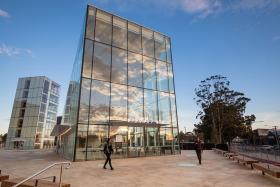Features and considerations: Personal security
An appropriate level of security is required in all public libraries to ensure the safety of staff, users, the building and the collection.
Good security can be designed into the library from the outset through clear sightlines, good positioning of the service desk and the avoidance of blind spots. Electronic surveillance, although often necessary, can become intrusive and can affect the friendliness of the library.
Designing security
Electronic surveillance
Surveillance cameras and distress alarms should be considered where:
- the library is used for customer service activities such as rates payments or other uses involving the handling of money
- a lone staff person operates a facility
- where staff and consultants agree that additional security should be provided.
Precautions
Libraries may suffer vandalism and damage. To counter the possibility of vandalism, the following precautions can be taken:
- design the building so that there are no concealed corners with windows (particularly louvres or sliding windows) which can be broken or forced
- provide night security lighting
- provide alarms connected to any windows or doors that can be forced
- locate the library in an area where there is good passive surveillance from adjoining land uses (e.g. residents, business owners) and passing pedestrian and vehicular traffic
- reduce the amount of blank wall space, as it is attractive for graffiti, and/or use building materials which are difficult to graffiti
- consider building materials which can easily be cleaned, repainted or replaced.
Exits from the library must be limited and controlled to avoid illegal removal of library materials. Any necessary fire exits must be designed so that they cannot be used other than for the designated purpose. Similarly, the exterior of the building should be designed with clear lines of sight around the building, appropriate light levels and designed to avoid blind spots.
Crime prevention through environmental design (CPTED)

Crime prevention through environmental design (CPTED) is the use of effective design strategies to improve the safety and quality of urban environments. The aim of CPTED is to reduce opportunities for crime, create safe environments and increase the amenity, attractiveness and safety of cities and towns. The NSW Government’s CPTED Unit provides advice and training on matters relating to CPTED.
The CPTED guidelines are used to assess the appropriateness of proposed developments to provide a safe, crime-free environment. The guidelines were prepared in conjunction with the NSW Police.
The guidelines are in two parts: Safer by Design Evaluation and CPTED Principles and strategies. Further information can be found on the NSW Police website.
The guidelines have adopted the following design principles:
Territorial reinforcement
Areas that are well-maintained have a feeling of “ownership” and are well-used, which reduces opportunities for criminal activity. Public areas, and private areas within public spaces, need to clearly define their intended use and encourage community activity.
Surveillance
Natural and technical surveillance are important and focus on ensuring that people can see what other people are doing. There needs to be clear sightlines in public areas and from private to public areas. Effective lighting of public places and landscaping is required to prevent areas for people to hide or entrap victims. Private areas need to have well-defined, well-lit entries with incorporated safety provisions. Electronic surveillance can be used as a deterrent. It is particularly effective where cameras are visible, for broader surveillance where natural surveillance cannot be achieved and is useful as an evidence tool used by police.
Access control
Public places need to be clear in their definition of where people can and cannot go and to define private property boundaries. The use of physical barriers (fencing, walls and locked doors) and symbolic barriers (landscaping and changes in level) are important in access control. This is equally important for primary and ancillary areas (car park, garbage collection area and storage areas).
Space management
Areas need to be attractive and well-maintained with regular removal of waste, mowing, removal of graffiti, repair of vandalism and refurbishment of old equipment and furniture. It is recommended that these design principles be applied as part of the planning process for the proposed library site.